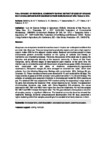Please use this identifier to cite or link to this item:
http://www.alice.cnptia.embrapa.br/alice/handle/doc/1037803| Title: | Dynamic of microbial community during distinct stages of organic matter decomposition in sediments from mangroves of São Paulo state. |
| Authors: | MOITINHO, M. A.  YOSHIURA, C. A.   BONONI, L.   VASCONCELLOS, R. L. F.   MELO, I. S. de   TAKETANI, R. G.   |
| Affiliation: | M. A. MOITINHO, ESALQ/USP; C. A. YOSHIURA, CENA/ESALQ/USP; L. BONONI, ESALQ/USP; R. L. F. VASCONCELLOS, CENA/ESALQ/USP; ITAMAR SOARES DE MELO, CNPMA; R. G. TAKETANI, Bolsista Fapesp. |
| Date Issued: | 2015 |
| Citation: | In: CONGRESSO BRASILEIRO DE MICROBIOLOGIA, 28., Florianópolis. Anais... Florianópolis: Sociedade Brasileira de Microbiologia, 2015. Ref. 0969-1. |
| Description: | Abstract: Mangroves are ecosystems located at coastline areas in tropical and subtropical conditions that are under tide influences. They are recognized as productive regions and have a high export of organic matter (OM) for the adjacent coastal waters. Bacterial communities present in these environments perform primordial functions on the cycling of nutrients and thereby on maintaining your important processes. Therefore, the purpose of this study was to assess the dynamics and phylogenetic diversity of the bacterial community in threes of São Paulo mangroves, during different stages of decomposition plant material. At the same time, the intention was to correlate this event with the emission of greenhouse gases (GHG). Microcosms were constructed with leaf discs of Avicennia schaueriana (A), Laguncularia racemosa (L), Rhizophora mangle (R) were arranged on sediment and water, which were collected from the following Mangroves: Bertioga with contamination (BC), Bertioga (B) and Cananeia (C). These microenvironments were stored at 24 °C and monitored for 60 days. The measurements of gases and DNA extraction were performed at the 7, 15, 30 and 60 days. The collected air samples were analyzed in triplicate in chromatograph model GC-2014 greenhouse gas. The obtained DNA was subjected to PCR reactions aiming the sequencing in large scale of the gene that encoding the ribosomal rRNA Domain Bacteria by Ion Torrent. The assessment of communities dynamics was made with Qiime. Regarding CO2 emissions, the values observed for AB7, RB7 and RBC7 were higher than the other treatments. For N2O the samples AB, ABC7 and RBC7 showed the higher rates. The CH4 gas obtained a homogeneous result for all samples, seeing no significant difference. The bacterial community dynamics showed that treatments: Bertioga, Avicennia schaueriana and decomposition time 60 days, presented a higher clustering within their samples, according to the standard of similarity observed in them. |
| NAL Thesaurus: | Greenhouse gases microorganisms |
| Keywords: | Plant degradation Ecological soccessions |
| Type of Material: | Resumo em anais e proceedings |
| Access: | openAccess |
| Appears in Collections: | Resumo em anais de congresso (CNPMA)  |
Files in This Item:
| File | Description | Size | Format | |
|---|---|---|---|---|
| 2015RA009.pdf | 113.9 kB | Adobe PDF |  View/Open |









